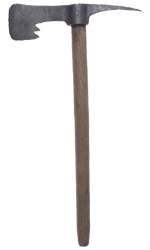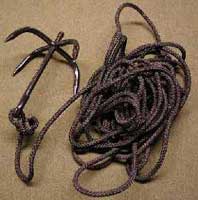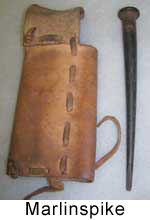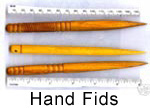Traveling within the World
Linking your favorite traveling artists across the globe
Belaying Pins
|
Tags:
Replies to This Discussion
-
Permalink Reply by Dept of PMM Artists & things on February 8, 2011 at 4:37pm
-
Boarding Axes & Tomahawks

Boarding Axes, with a two or three-foot handle and a combination of sharp blade and blunt hammer side, were used to cut the ropes of boarding hooks, bring downs masts and rigging, and generally tear through anything that stood in the way of the loot, like doors, hatches or locks. They could at times help steady the weight of a boarder if needed for climbing from a smaller boat to a larger vessel (a portable handle).
The boarding axe however, had other very important duties. It was used in fire fighting to chisel out hot cannon balls that could ignite ships' timbers. The broad blade end was used to cut through downed rigging and as a hook to drag the rigging and debris out of the way.
-
-
Permalink Reply by Dept of PMM Artists & things on February 8, 2011 at 4:37pm
-
Boarding Hooks
(a.k.a. Grappling Hook, Grapple, Grappler)

A Boarding Hook (or "grappling hook") is a composite hook attached to a rope, designed to be thrown or projected a distance, where its hooks will engage with the target. Grappling hooks were originally used in naval warfare to catch the rigging of an enemy ship so that it could be drawn in and boarded.
The most common design consists of a central shaft with a hole at the base of the shaft, called an "eye" to attach the rope, and three equally spaced hooks at the end of the shaft, so arranged that at least one is likely to catch on some protuberance of the target.
-
-
Permalink Reply by Dept of PMM Artists & things on February 8, 2011 at 4:38pm
-
Caltrop
(a.k.a. Crowsfoot, Calthrop, Jack Rock, Star Nail)

The artifact shown on the left is a caltrop that was unearthed in an excavation near Jamestown, and is a great example of the simplistic design of a caltrop. The weapon was generally crafted from scrap iron and forged into shape with 4 iron points. This design insured that no matter how the caltrop may land, 1 point will always project upwards.
Since most sailors tended to work barefoot on board a ship to avoid slipping on wet decks and for general comfort, Pirates would sometimes toss caltrops or crowsfeet onto the deck of a ship they were preparing to board. The spikes could inflict terrible injuries or extreme pain if trodden on, and at the very least add confusion and chaos to a ship as it tried to defend itself.
The military device, sometimes written and said caltrap, appears to have been named after one of a number of plants with spiny burrs. For obvious reasons it’s another name for the star thistle (Centaurea calcitrapa). It’s a local name for the curled pondweed (Potomageton crispus), which produces lots of winter seeds that are hard and burr-like. A plant called the water chestnut (Trapa natans) is also known as the water caltrop, which has fruit with two spines that are hard enough to penetrate the hooves of stock as well as human feet.
The word derives from the Old English calketrippe, for any plant that tended to catch the feet. In turn this comes from the medieval Latin calcatrippa, a compound either of calx, “heel” or calcare, “to tread”, with a word related to “trap” that came from one of the Germanic languages. The military sense of the word probably came into English from French usage. -
-
Permalink Reply by Dept of PMM Artists & things on February 8, 2011 at 4:39pm
-
Marlin Spikes & Hand Fids

The Marlinespike (or "hand fid" if made of wood) held the Most Favored Weapon status among those with mutiny on their mind.
They were pointed iron or steel hand tools carried by deck hands (Boatswain’s Mates particularly.) Normally no shorter than 6 inches and no longer than 18, marline spikes are used in various shipboard tasks including separating the strands of heavy rope lines and prying open diverse shipboard containers. Marlinespikes were also used as hammers, paint-chippers, eating utensils, tea and coffee-stirrers, and to repair sails.
Although very useful and invaluable tools for maintaining a ship in the age of sail, they also made excellent weapons. Made of hard, durable materials and fashioned to a point they hade either good blunt instruments good for cracking a skull or as an impromptu dagger.

-
Events
-
2014 is the Chinese Year of the Horse
February 17, 2026 at 12am to February 5, 2027 at 12am – where & how you choose
Birthdays
Birthdays Today
Birthdays Tomorrow
Important (read & understand)
Skype: Travelingraggyman
Email and Instant Messenger:
TravelerinBDFSM @ aol/aim; hotmail; identi.ca; live & yahoo
OR
Travelingraggyman @ gmail and icq ***

1AWARD UPDATES & INFORMATION
10,000 votes - Platinum Award
5,000 votes - Gold Award
2,500 votes - Silver Award
1,000 votes - Bronze Award
300 votes - Pewter Award
100 votes - Copper Award
Member of the Associated Posting System {APS}
This allows members on various sites to share information between sites and by providing a by line with the original source it credits the author with the creation.
Legal Disclaimer
***************We here at Traveling within the World are not responsible for anything posted by individual members. While the actions of one member do not reflect the intentions of the entire social network or the Network Creator, we do ask that you use good judgment when posting. If something is considered to be inappropriate it will be removed
Site Meter
This site is strictly an artist operational fan publication, no copyright infringement intended
Patchwork Merchant Mercenaries had its humble beginnings as an idea of a few artisans and craftsmen who enjoy performing with live steel fighting. As well as a patchwork quilt tent canvas. Most had prior military experience hence the name.
Patchwork Merchant Mercenaries.
Vendertainers that brought many things to a show and are know for helping out where ever they can.
As well as being a place where the older hand made items could be found made by them and enjoyed by all.
We expanded over the years to become well known at what we do. Now we represent over 100 artisans and craftsman that are well known in their venues and some just starting out. Some of their works have been premiered in TV, stage and movies on a regular basis.
Specializing in Medieval, Goth , Stage Film, BDFSM and Practitioner.
Patchwork Merchant Mercenaries a Dept of, Ask For IT was started by artists and former military veterans, and sword fighters, representing over 100 artisans, one who made his living traveling from fair to festival vending medieval wares. The majority of his customers are re-enactors, SCAdians and the like, looking to build their kit with period clothing, feast gear, adornments, etc.
Likewise, it is typical for these history-lovers to peruse the tent (aka mobile store front) and, upon finding something that pleases the eye, ask "Is this period?"
A deceitful query!! This is not a yes or no question. One must have a damn good understanding of European history (at least) from the fall of Rome to the mid-1600's to properly answer. Taking into account, also, the culture in which the querent is dressed is vitally important. You see, though it may be well within medieval period, it would be strange to see a Viking wearing a Caftan...or is it?
After a festival's time of answering weighty questions such as these, I'd sleep like a log! Only a mad man could possibly remember the place and time for each piece of kitchen ware, weaponry, cloth, and chain within a span of 1,000 years!! Surely there must be an easier way, a place where he could post all this knowledge...
Traveling Within The World is meant to be such a place. A place for all of these artists to keep in touch and directly interact with their fellow geeks and re-enactment hobbyists, their clientele.
© 2025 Created by Rev. Allen M. Drago ~ Traveler.
Powered by
![]()
 A belaying pin is a device used on traditional sailing vessels to secure lines. Their function on modern vessels has been replaced by cleats, but they are still used, particularly on larger sailing ships.
A belaying pin is a device used on traditional sailing vessels to secure lines. Their function on modern vessels has been replaced by cleats, but they are still used, particularly on larger sailing ships.